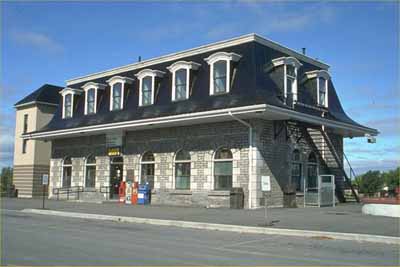Belleville Railway Station (Grand Trunk) National Historic Site of Canada
Belleville, Ontario

General view
(© Parks Canada Agency/ Agence Parcs Canada, 1990.)
Address :
220 Station Street, Belleville, Ontario
Recognition Statute:
Historic Sites and Monuments Act (R.S.C., 1985, c. H-4)
Designation Date:
1973-11-15
Dates:
-
1856 to 1856
(Construction)
Event, Person, Organization:
-
Grand Trunk Railway Company
(Organization)
-
Francis Thompson
(Architect)
-
Peto, Brassey, Jackson and Betts
(Builder)
Other Name(s):
-
Belleville Railway Station (Grand Trunk)
(Designation Name)
-
Grand Trunk Railway - Belleville
(Plaque name)
Research Report Number:
RSR-090
Plaque(s)
Unknown: 220 Station Street, Belleville, Ontario
The Grand Trunk was incorporated in 1853 to run from Sarnia to Portland, Maine. Although it took over existing lines, new ones had to be built, including sections of the key Toronto to Montreal line completed by the noted English engineering firm of Peto, Brassey, Jackson and Betts in 1856. The Belleville station, built about 1856, is representative of the larger stations erected by this firm for the Grand Trunk Railway. Although its design was influenced by English railway stations, it is an enduring monument to early Canadian railway enterprise.
Description of Historic Place
The Belleville Railway Station is a one-and-a-half-storey, stone railway station, built in the mid-19th century. It is located in the city of Belleville. The formal recognition consists of the building on its footprint.
Heritage Value
The Belleville Railway Station was designated a national historic site because it is representative of the larger stations for the Grand Trunk Railway (GTR) and because it is an enduring monument to early Canadian railway enterprise.
The Belleville Railway Station is a good example of the larger stations erected for the newly-formed GTR along the key Toronto to Montreal line during the mid-19th century. Built in 1855-56 by the noted English engineering firm of Peto, Brassey, Jackson and Betts, it is a variation on the standard GTR Second Class Wayside Station design developed by GTR Chief Architect Francis Thompson. The original one-storey, Italianate-style structure was altered in the late 19th-century by the addition of a mansard roof in the Second Empire style.
As a major divisional point on the GTR line between Montreal and Toronto, the Belleville station was a prominent part of a system which radically improved overland transportation and had a profound effect on the economics of the province. The railway was instrumental in the 19th-century growth of the town of Belleville.
Sources: Historic Sites and Monuments Board of Canada, Minutes, 1973; Historic Sites and Monuments Board of Canada, Plaque Text, 1979.
Character-Defining Elements
The key elements that relate to the heritage value of the Belleville Railway Station are:
the well-proportioned, rectangular composition of its main storey, with six arched bays on the long sides, and two on each end its relatively large size, in keeping with its status as a divisional point station the picturesque, Italianate style of its main storey, including: the round-arched openings; the symmetrical placement and even sizing of openings; the rusticated stonework; the elaborate door and window surrounds; the corner quoins; and the deep eaves its Second-Empire-style additions, including: a bellcast mansard roof; wide eaves; heavily moulded segmental dormers on all sides aligned with the bays of the main storey; and heavily articulated cornice mouldings capping the dormers and the roof its roof materials, consisting of metal shingles
- its fine stonework, consisting of: bluish-grey, Trenton limestone laid in narrow courses of small blocks; with lighter-coloured, sawn limestone accents at corners and openings the rustication of the stone accents, reminiscent of vermiculation the arrangement of stone accents at openings, consisting of alternating large and small voussoirs the central jamb shared by the two openings on each end wall, a feature unique to the Belleville station its relationship with the adjacent tracks